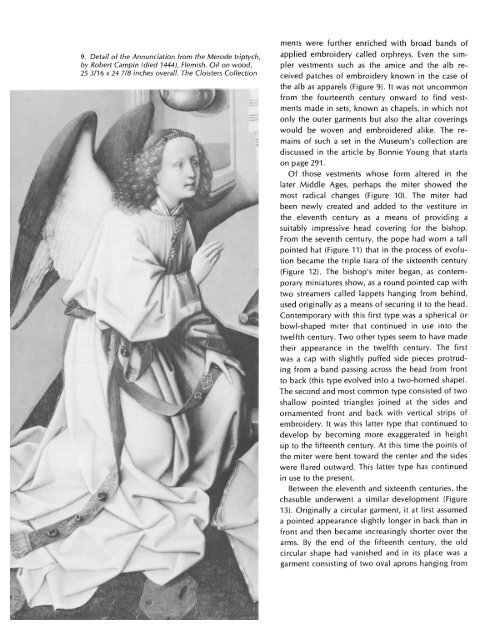The Metropolitan Museum of Art Bulletin, v. 29, no. 7 (March, 1971)
The Metropolitan Museum of Art Bulletin, v. 29, no. 7 (March, 1971)
The Metropolitan Museum of Art Bulletin, v. 29, no. 7 (March, 1971)
Create successful ePaper yourself
Turn your PDF publications into a flip-book with our unique Google optimized e-Paper software.
9. Detail <strong>of</strong> the Annunciation from the Merode triptych,<br />
by Robert Campin (died 1444), Flemish. Oil on wood,<br />
25 3/16 x 24 7/8 inches overall. <strong>The</strong> Cloisters Collection<br />
ments were further enriched with broad bands <strong>of</strong><br />
applied embroidery called orphreys. Even the simpler<br />
vestments such as the amice and the alb received<br />
patches <strong>of</strong> embroidery k<strong>no</strong>wn in the case <strong>of</strong><br />
the alb as apparels (Figure 9). It was <strong>no</strong>t uncommon<br />
from the fourteenth century onward to find vestments<br />
made in sets, k<strong>no</strong>wn as chapels, in which <strong>no</strong>t<br />
only the outer garments but also the altar coverings<br />
would be woven and embroidered alike. <strong>The</strong> remains<br />
<strong>of</strong> such a set in the <strong>Museum</strong>'s collection are<br />
discussed in the article by Bonnie Young that starts<br />
on page <strong>29</strong>1.<br />
Of those vestments whose form altered in the<br />
later Middle Ages, perhaps the miter showed the<br />
most radical changes (Figure 10). <strong>The</strong> miter had<br />
been newly created and added to the vestiture in<br />
the eleventh century as a means <strong>of</strong> providing a<br />
suitably impressive head covering for the bishop.<br />
From the seventh century, the pope had worn a tall<br />
pointed hat (Figure 11) that in the process <strong>of</strong> evolution<br />
became the triple tiara <strong>of</strong> the sixteenth century<br />
(Figure 12). <strong>The</strong> bishop's miter began, as contemporary<br />
miniatures show, as a round pointed cap with<br />
two streamers called lappets hanging from behind,<br />
used originally as a means <strong>of</strong> securing it to the head.<br />
Contemporary with this first type was a spherical or<br />
bowl-shaped miter that continued in use into the<br />
twelfth century. Two other types seem to have made<br />
their appearance in the twelfth century. <strong>The</strong> first<br />
was a cap with slightly puffed side pieces protruding<br />
from a band passing across the head from front<br />
to back (this type evolved into a two-horned shape).<br />
<strong>The</strong> second and most common type consisted <strong>of</strong> two<br />
shallow pointed triangles joined at the sides and<br />
ornamented front and back with vertical strips <strong>of</strong><br />
embroidery. It was this latter type that continued to<br />
develop by becoming more exaggerated in height<br />
up to the fifteenth century. At this time the points <strong>of</strong><br />
the miter were bent toward the center and the sides<br />
were flared outward. This latter type has continued<br />
in use to the present.<br />
Between the eleventh and sixteenth centuries, the<br />
chasuble underwent a similar development (Figure<br />
13). Originally a circular garment, it at first assumed<br />
a pointed appearance slightly longer in back than in<br />
front and then became increasingly shorter over the<br />
arms. By the end <strong>of</strong> the fifteenth century, the old<br />
circular shape had vanished and in its place was a<br />
garment consisting <strong>of</strong> two oval aprons hanging from

















